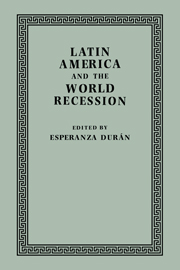1 - The Political Setting: ‘Business as Usual’ or a New Departure?
Published online by Cambridge University Press: 05 February 2012
Summary
Elsewhere in this volume, contributions about individual countries or on specific economic topics should help to dispel any notion that the economic problems of the continent are easily diagnosed or, least of all, easily forecast. In the political sphere, however, simplistic ideas – whether about the nature of regimes or of the effect of the international economy on the internal politics of Latin America – continue to flourish. It might, then, be useful to look in general terms at the politics of Latin American countries and to analyse the impact of the world economy on Latin American regimes. The basic theme of this introductory chapter is that analysis of Latin American politics has been bedevilled by false and naive assumptions about the relationship between international economics and internal politics. The world economic recession, and its impact on Latin American politics since the early 1970s, provide ample material for a questioning of those assumptions.
Basically, the usual assumptions are as follows. Many countries in Latin America were formally democratic and had popular governments in the 1960s and 1970s. The Goulart government in Brazil, the Belaunde government in Peru, the Frei and Allende governments in Chile, and the Radical administration of President Illia in Argentina, as well as the later Peronist government there, were all overthrown by the military after attempting to broaden participation and provide some social and economic advances for the masses.
- Type
- Chapter
- Information
- Latin America and the World Recession , pp. 1 - 14Publisher: Cambridge University PressPrint publication year: 1985



